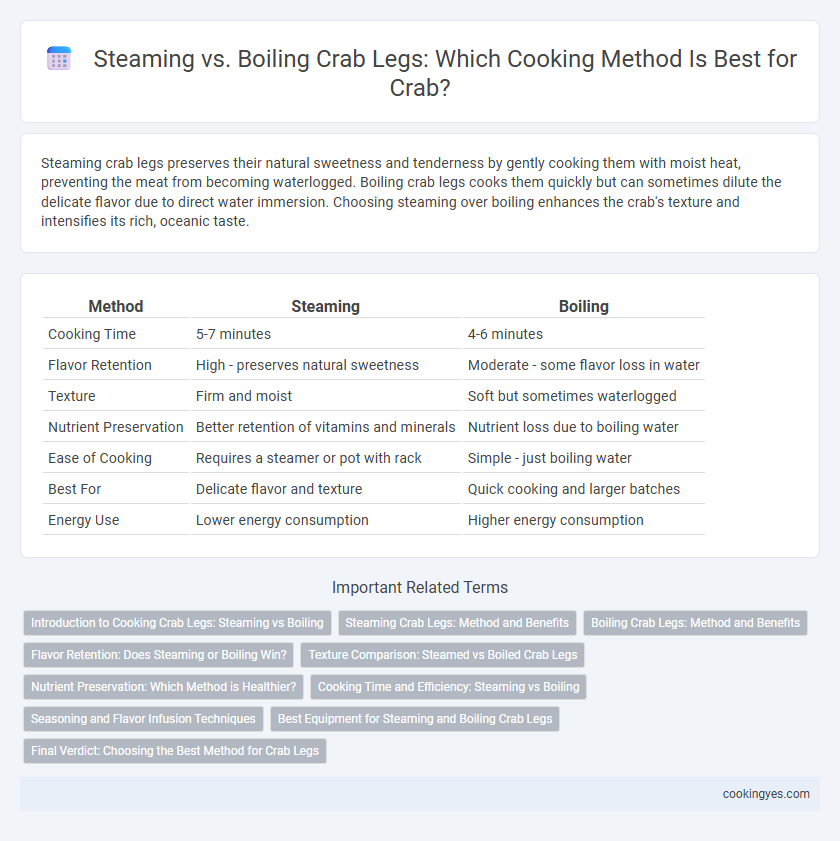Steaming crab legs preserves their natural sweetness and tenderness by gently cooking them with moist heat, preventing the meat from becoming waterlogged. Boiling crab legs cooks them quickly but can sometimes dilute the delicate flavor due to direct water immersion. Choosing steaming over boiling enhances the crab's texture and intensifies its rich, oceanic taste.
Table of Comparison
| Method | Steaming | Boiling |
|---|---|---|
| Cooking Time | 5-7 minutes | 4-6 minutes |
| Flavor Retention | High - preserves natural sweetness | Moderate - some flavor loss in water |
| Texture | Firm and moist | Soft but sometimes waterlogged |
| Nutrient Preservation | Better retention of vitamins and minerals | Nutrient loss due to boiling water |
| Ease of Cooking | Requires a steamer or pot with rack | Simple - just boiling water |
| Best For | Delicate flavor and texture | Quick cooking and larger batches |
| Energy Use | Lower energy consumption | Higher energy consumption |
Introduction to Cooking Crab Legs: Steaming vs Boiling
Steaming crab legs preserves their natural sweetness and minimizes nutrient loss by cooking them gently with moist heat, while boiling submerges them in rapidly boiling water, which can lead to slight texture softening. Steaming typically requires a covered pot with a small amount of water and lasts about 5-7 minutes for pre-cooked crab legs, ensuring even heat distribution. Boiling crab legs takes roughly the same time but can dilute the flavor and leach out some minerals, making steaming the preferred method for maintaining optimal taste and texture in crab leg preparation.
Steaming Crab Legs: Method and Benefits
Steaming crab legs preserves their natural sweetness and delicate texture by cooking them gently with indirect heat, preventing waterlogged meat that often results from boiling. This method retains more nutrients, including essential minerals like zinc and magnesium, while maintaining the crab's vibrant color and succulence. Steaming also allows for better control over cooking time, reducing the risk of overcooking and ensuring tender, flavorful crab legs.
Boiling Crab Legs: Method and Benefits
Boiling crab legs involves submerging them in rapidly boiling water seasoned with salt and aromatics for 4-6 minutes, ensuring even cooking and moist, tender meat. This method helps retain the crab's natural flavors while speeding up the cooking process compared to steaming. Boiling also allows easy preparation of large quantities, making it efficient for gatherings or seafood feasts.
Flavor Retention: Does Steaming or Boiling Win?
Steaming crab legs preserves more of their natural sweetness and delicate texture by preventing direct contact with water, which can dilute the flavor. Boiling often leads to leaching of essential minerals and subtle taste compounds into the water, reducing overall flavor intensity. For optimal flavor retention, steaming is the preferred cooking method, ensuring juicy, tender crab meat with enhanced taste.
Texture Comparison: Steamed vs Boiled Crab Legs
Steamed crab legs retain a firmer, more succulent texture due to the gentle cooking process that preserves natural moisture and flavor. Boiled crab legs tend to be softer and may absorb more water, sometimes resulting in a slightly less intense taste. For a premium dining experience, steaming enhances the crab's delicate meat texture while maintaining its sweet, briny essence.
Nutrient Preservation: Which Method is Healthier?
Steaming crab legs retains more water-soluble vitamins like B12 and B-complex compared to boiling, which can leach nutrients into the cooking water. The gentle steam heat preserves the crab's delicate protein structure, enhancing bioavailability and flavor without nutrient loss. Choosing steaming over boiling supports better nutrient preservation and a healthier crab leg meal.
Cooking Time and Efficiency: Steaming vs Boiling
Steaming crab legs typically takes about 5-7 minutes, preserving their natural flavor and preventing waterlogging, while boiling requires around 4-6 minutes but can dilute the taste due to direct water immersion. Steaming is more efficient for maintaining texture and moisture, especially when cooking smaller batches, whereas boiling is faster for cooking large quantities evenly. Choosing steaming enhances the crab's tender meat quality without the risk of overcooking common in boiling methods.
Seasoning and Flavor Infusion Techniques
Steaming crab legs preserves their natural sweetness while allowing subtle seasoning like Old Bay or lemon butter to gently infuse during cooking. Boiling crab legs often results in a more robust flavor as spices added directly to the water penetrate the meat more deeply. Both methods benefit from soaking crab legs in seasoned water or brushing with garlic herb butter post-cooking for enhanced flavor infusion.
Best Equipment for Steaming and Boiling Crab Legs
A large, deep pot with a steaming rack is ideal for steaming crab legs, ensuring even heat distribution and preventing the legs from submerging in water to retain natural flavors. For boiling crab legs, a spacious stockpot with a tight-fitting lid and sturdy handles is essential to handle the volume of water and maintain a consistent boil. High-quality stainless steel or enameled pots provide durability and ease of cleaning for both cooking methods.
Final Verdict: Choosing the Best Method for Crab Legs
Steaming crab legs preserves more natural flavor and moisture, making them tender and juicy compared to boiling. Boiling cooks crab legs faster and can be ideal for large batches but may result in slightly diluted taste. For the best balance of flavor and texture, steaming is generally recommended as the preferred method for crab legs.
Steaming vs Boiling for Crab Legs Infographic

 cookingyes.com
cookingyes.com